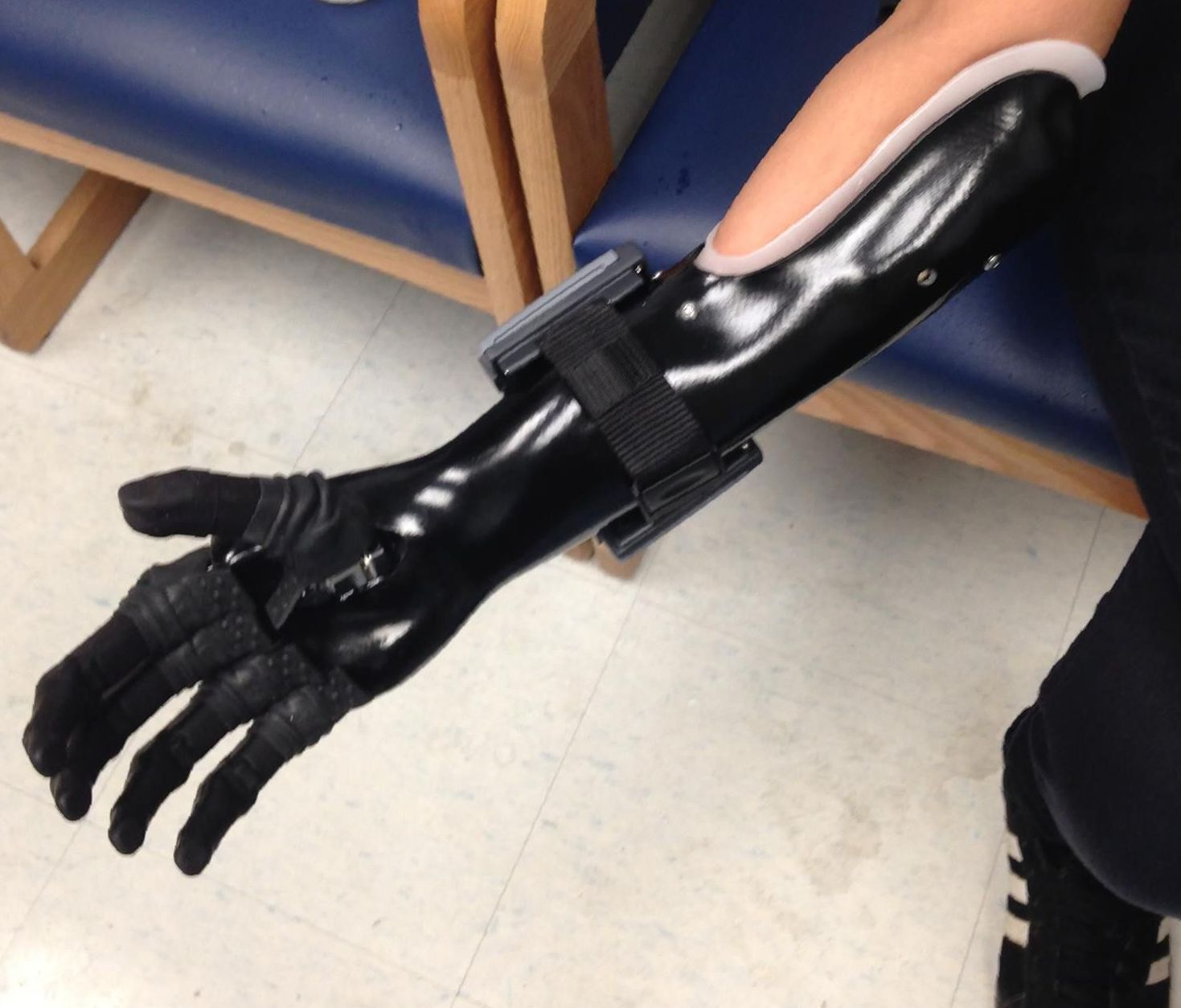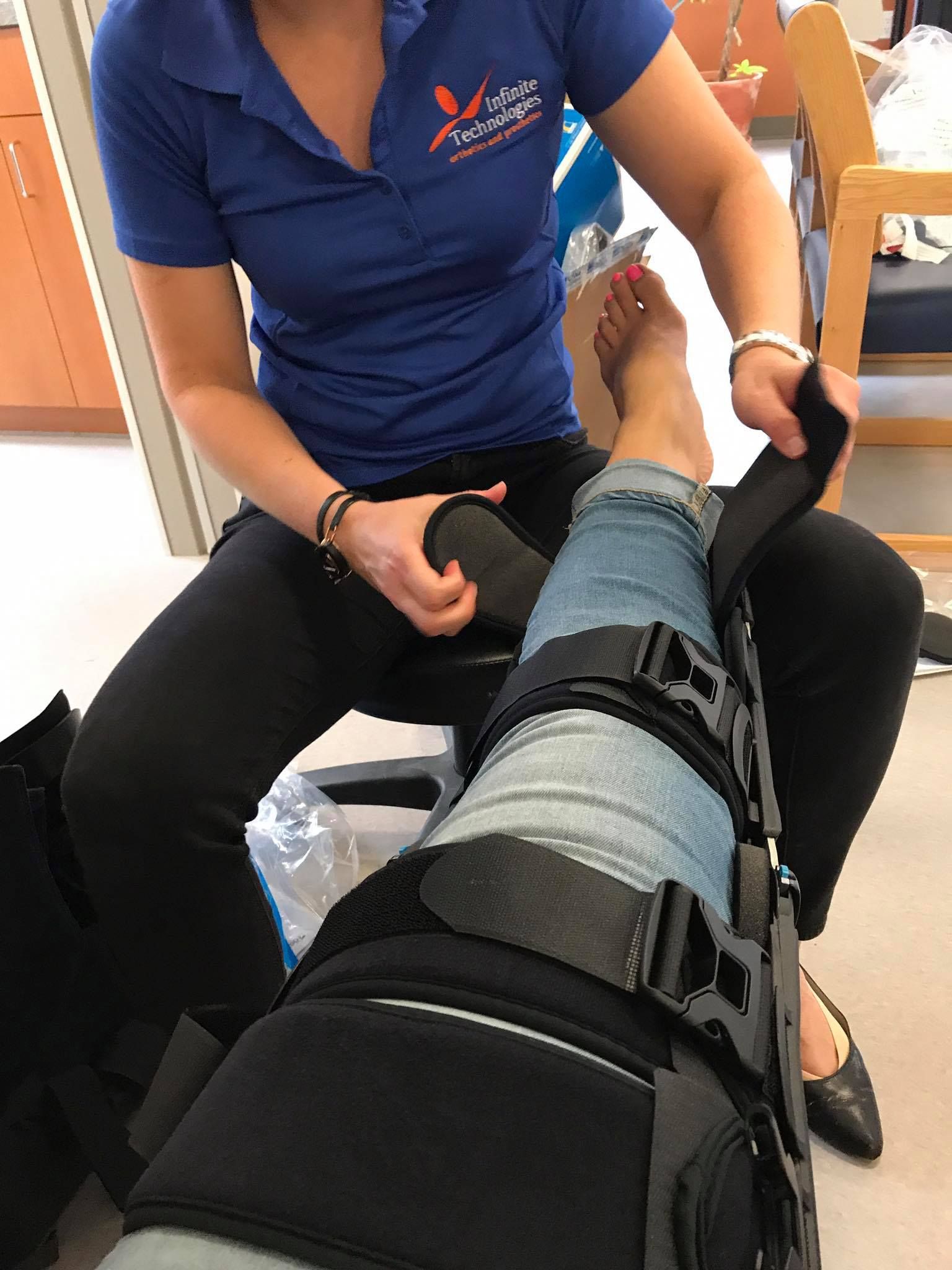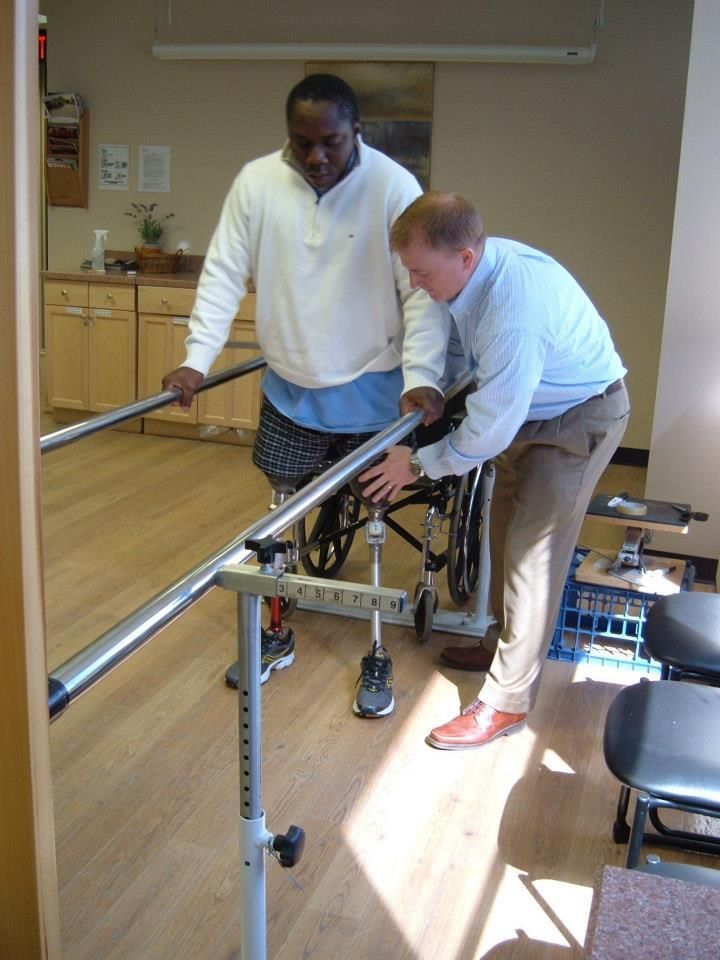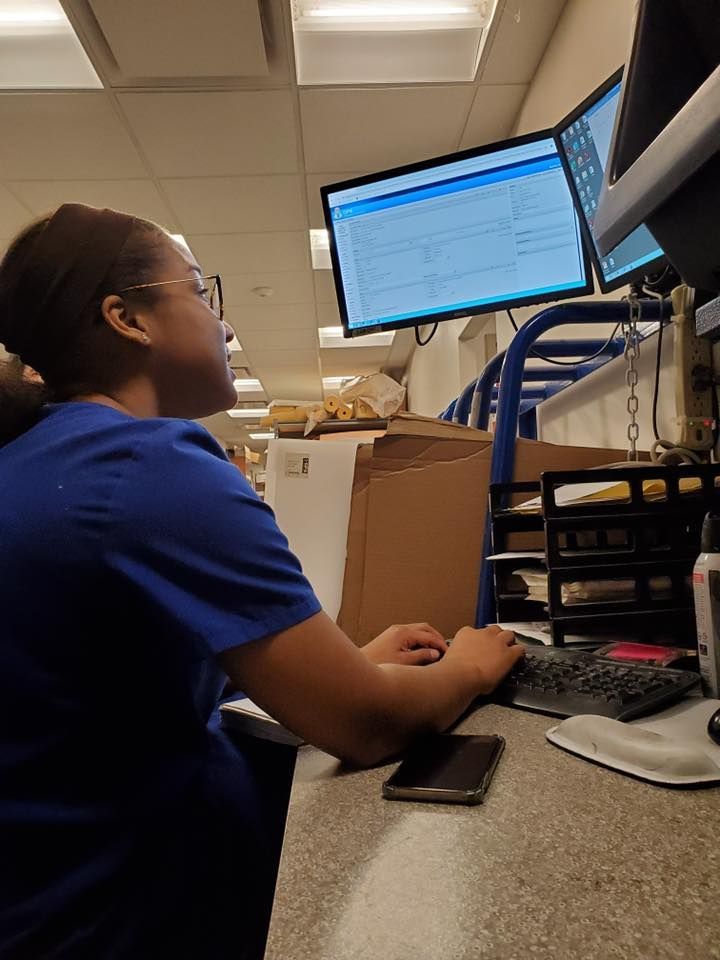Contact Us
Below Knee
Below Knee Leg Prosthetics
A below knee (BK) or transtibial (TT) prosthesis is custom made for a person who has had a BK or TT amputation. The prosthesis consists of a custom made socket, liner, pylon, and foot. Sometimes the prosthesis may consist of a sleeve or other harness, depending on the suspension system used for that patient.
Beginning the Process
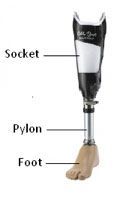
The process to start getting a BK prosthesis can start as soon as a few days/weeks after the amputation. The patient can be fit with an IPOP (Flotech, Ampushield or custom made) in the hospital or rehab center to help to protect patients’ surgical wounds, promote healing, controls swelling/edema and allows patients to become accustomed to wearing a device. The patient can also be fit with a BK Shrinker. A shrinker is a compressive garment that is used to help shape the limb for prosthetic process and reduce edema in the residual limb. It is similar in concept to using ace wrap, but the benefit is that the same compression will be applied throughout the limb, even when donned by different people. This will also help to desensitize the limb to get it ready for a prosthetic socket. These shrinkers are usually made by Juzo and Compressogrip- Knite Rite. After surgery, the patient’s limb will change size and shape up to the next year. The shrinker will help stabilize the limb size earlier on and give the patient a more successful prosthetic experience.
Liners and Cast/Scan
The next step in the process is to have the patient fit with a liner. The liner is a soft interface that the patient wears over the skin. It is donned before the socket. The main function of the liner is to absorb the forces created when ambulating in your prosthesis, to keep your residual limb healthy, and to allow you to wear the prosthesis for longer.
There are many different liners on the market and your prosthetist will pick the best liner for you. This is based on many factors, including suspension type, activity level, skin issues, hand dexterity, boney prominences , shape, etc. There are off-the-shelf (OTS) and custom liners. If the residual limb is an uncommon shape or very boney, custom liners may be used. These are made by taking an impression of the patient’s limb via a plaster cast or scan using our several different scanners/software. The process of obtaining a custom liner takes longer than obtaining an OTS liner. If the shape of the limb is common, measurements are taken to order the proper sized OTS liner.
Once the liner is ready to be fit on the patient, they are called to come back into the office for a casting appointment. The liner will be donned onto the patient’s limb and the fit will be assessed. If the fit is well, measurements and a cast of the limb will be taken over the liner. Different casting methods will be used based upon the suspension style that was previously decided upon by the prosthetist and patient. From here, the cast will be filled and modified appropriately to make your custom BK diagnostic prosthetic socket.
Diagnostic sockets
The first prosthetic socket you will receive will be called a diagnostic socket. This socket will be made of a clear plastic, utilizing the appropriate suspension method (pin/locking, elevated vacuum, suction). The socket will be attached to a tech plate. Componentry, such as adaptors and a pylon, will be used to attach the bottom of the socket to the chosen foot. Usually, these sockets are made to be taken home by the patient. A plastic diagnostic socket is used to start with as parts of the socket may need to be modified to appropriately contour to your limb. This can be easily done by heated and flaring the plastic. The limb will also reduce in size and change shape once you start walking on it. This is due to the new forces that are being applied to your limb when you are using your prosthesis. Volume loss is common and expected in your first prosthesis. When the socket feels loose and you are able to don the prosthesis a little too easily, you may need socks to take up this loss of volume. Volume loss can be addressed by using socks, which come in different plies (1,2,3,5,6). The higher the number of ply, the thicker the sock. This can help prevent your limb from moving around in the socket too much, which can leading to limb soreness, redness, bruising and edema. The height of the prosthesis will be set the appropriate length for the patient. Alignment will be adjusted through the different componentry to give the patient the best gait.
Usually, a second diagnostic socket is needed for new amputees due residual limb volume reduction. If this happens, a new liner may need to be ordered and then the patient will need to be cast/scanned over the new liner, just like the first time.
Laminated/Final socket
Once limb volume has stabilized and the diagnostic prosthetic socket fits the patient well, we can move on to the laminated socket. The laminated socket is fabricated using carbon fiber, which means it is much lighter than the plastic socket and has a higher tensile strength. Carbon fiber is also more durable, son the socket will be able to last up to a few years, depending on activity level and any limb changes. The patient can choose to have the socket custom designed/colored to meet their personality, which may to have the socket color match their skin tone or have their favorite sports team logo on the socket.
The prosthesis will be donned with the patient several times, allowing the patient to be able to don/doff it themselves. Height and alignment will be adjusted accordingly. Gait training will be performed to help the patient get use to using the limb. Physical therapy will play an important part of gait training and strengthening their lower limb muscles outside of appointments with your prosthetist.
Ankle Disarticulation Prosthesis
The ankle disarticulation amputation is also known as a Symes amputation. these extent from the lateral malleolus, or ankle bone, to the medial malleolus, essentially removes the entire foot, then forward rotation of the heel pad over the end of the residual tibia.
Unlike transtibial amputees, many patients with symes amputations are able to fully bear weight on the bottom of the residual limb. Therefore, the socket design for a symes amputation is slightly different than the transtibial socket. While pressure must be still redistributed throughout the limb, more emphasis placed on the distal end or very bottom of the prosthesis, as tolerated. The carbon fiber frame is then connected directly to the prosthetic foot. The foot will need to be very low profile and have a very small build height. This includes feet such as the Endolite Esprit and Ability Dynamics Rush Rover.
With Symes prostheses, there are many different designs and approaches to a socket. Many sockets incorporate a removable window to allow the limb to pass through the narrow region, which then locks into place, usually by a Velcro strap. There can be either a posterior or medial opening. Other sockets lock onto the patient’s boney anatomy for suspension. In these cases, a liner may be used. Since there is no pylon or connection tube between the bottom of the socket and the prosthetic foot, the Symes socket is usually bulky on either side of the ankle.
We perform this process very similar to the above knee amputees, in that we do two diagnostic sockets in house and have a foot attached to allow for ambulation. This will allow us to get proper alignment of the foot to the socket to give the patient the best biomechanical advantage. Once the alignment is optimal and the socket fits well, the definitive/final socket is fabricated.
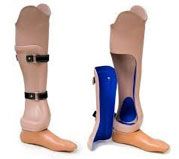
Ankle Disarticulation Prosthesis
The ankle disarticulation amputation is also known as a Symes amputation. these extent from the lateral malleolus, or ankle bone, to the medial malleolus, essentially removes the entire foot, then forward rotation of the heel pad over the end of the residual tibia.
Unlike transtibial amputees, many patients with symes amputations are able to fully bear weight on the bottom of the residual limb. Therefore, the socket design for a symes amputation is slightly different than the transtibial socket. While pressure must be still redistributed throughout the limb, more emphasis placed on the distal end or very bottom of the prosthesis, as tolerated. The carbon fiber frame is then connected directly to the prosthetic foot. The foot will need to be very low profile and have a very small build height. This includes feet such as the Endolite Esprit and Ability Dynamics Rush Rover.
With Symes prostheses, there are many different designs and approaches to a socket. Many sockets incorporate a removable window to allow the limb to pass through the narrow region, which then locks into place, usually by a Velcro strap. There can be either a posterior or medial opening. Other sockets lock onto the patient’s boney anatomy for suspension. In these cases, a liner may be used. Since there is no pylon or connection tube between the bottom of the socket and the prosthetic foot, the Symes socket is usually bulky on either side of the ankle.
We perform this process very similar to the above knee amputees, in that we do two diagnostic sockets in house and have a foot attached to allow for ambulation. This will allow us to get proper alignment of the foot to the socket to give the patient the best biomechanical advantage. Once the alignment is optimal and the socket fits well, the definitive/final socket is fabricated.
Technologies / Devices
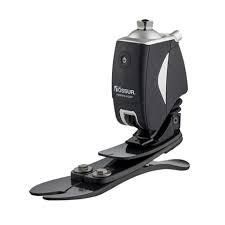
Proprio Foot
The PROPRIO FOOT offers an unprecedented level of mobility and stability. The powered ankle motion, intelligent terrain adaptation, and natural function of PROPRIO FOOT make it the most life-like prosthetic foot available, giving its users the power to overcome all of life’s obstacles.
LEARN MORE →

Empower Foot
The EMPOWER FOOT System is the only commercially-available device for amputees that provides natural Bionic Propulsion. The EMPOWER FOOT System is the only ankle-foot device that will enable your patients to achieve a normalized biomimetic response across all level-ground walking speeds.
LEARN MORE →
Demonstration Videos
WHY CHOOSE US
What Makes Infinite Technologies Different
Comprehensive Approach to Care
Empowerment Through Education
Goal Setting
Lifelong Partnerships
Your Personal
Health Champions
Infinite Technologies Orthotics and Prosthetics is the premier orthotic and prosthetic facility in the Mid-Atlantic region providing inpatient and outpatient services, consults, and evaluations for adult and pediatric patients. Through our unique approach to comprehensive care, education and goal setting, we forge lifelong partnerships with our patients in their efforts to heal, while introducing them to the most innovative technologies for their individualized treatment.
Get Started With Infinite Technologies
Take the first step towards a life of improved mobility. Schedule your free consultation with our experts at Infinite Technologies and see the difference personalized care can make.
Request An Appointment

